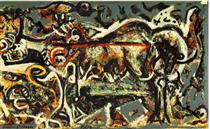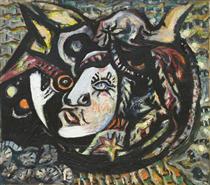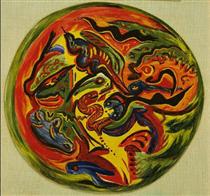
1912 - 1956
Paul Jackson Pollock

description
An American painter and a major figure in the Abstract expressionist movement. Paul Jackson Pollock had a significant impact on the art of the second half of the XX century and was well known for his unique style of drip painting.
From an early age, Jackson admired mysticism, especially the philosophy of Indian writer Jiddu Krishnamurti. His idea that the truth reveals itself to people only intuitively appealed to Pollock.
The artist created his own technique. He never made sketches before creating paintings, fully relying on his emotions and intuition. The painter put huge canvases on the floor. After that, Pollock took paints and threw them on the canvases not touching the surface. This is akin to the methods of the Indian sand painters of the West. Later on this technique was named “dripping”, however, the artist himself preferred to call it “flowing technique”. Thanks to this, his friends and colleagues called him Jack the Dripper.
Pollock usually gave his paintings numbers instead of names. He remains not only one of the most influential figures of Abstract expressionism, but also one of the most expensive artists in the world.
Key ideas:
– The artist preferred working on the floor or attaching the canvas to the wall. “I need the resistance of a hard surface. On the floor I am more at ease. I feel nearer, more part of the painting, since this way I can walk around it, work from the four sides and literally be in the painting,” he said.
– He loved painting with the help of different unusual tools. “I prefer sticks, trowels, knives and dripping fluid paint or a heavy impasto with sand, broken glass or other foreign matter added,” Pollock wrote.
When the artist began painting, he always deeply immersed into his own imagination. He tried to express his ideas perfectly and fully: “When I am in my painting, I’m not aware of what I’m doing. It is only after a sort of ‘get acquainted’ period that I see what I have been about. I have no fear of making changes, destroying the image, etc., because the painting has a life of its own. I try to let it come through. It is only when I lose contact with the painting that the result is a mess. Otherwise there is pure harmony, an easy give and take, and the painting comes out well.”
1912
1930
1943
1950
1956
The birth of the artist
Pollock moved to New York

The first personal exhibition

The pictures of Pollock creating his paintings.

The death

Paul Jackson Pollock
On Artist
flow
Cubism
Abstract Art
Surrealism
Regionalism
Folk art
friends
Robert Motherwell
Mark Rothko
Willem de Kuning
Barnett Newman
Philip Guston
Ed Reinhardt
Betty Parsons
artists
Pablo Picasso
Oscar-Claude Monet
El Greco
Paul Cezanne
Thomas Garth Benton
Jose Clemente Orozco
Joan Miro
Chaim Soutine
David Alfaro Siqueiros
Salvador Dali
Yves Tanguy
Stuart Davis
Paul Klee
Franz Marc
Diego Rivera
By Artist
friends
Lee Krasner
Robert Motherwell
Mark Rothko
Willem de Kuning
Barnett Newman
Philip Guston
artists
Helen Frankenthaler
Sai Twombly
Maurice Louis
Lee Krasner
Robert Morris
Kenneth Noland
Franz Klein
Gerhard Richter
Charles Gibbons
